The importance of team culture and dynamics and why they should be at the heart of any leader’s outlook on employee wellbeing.
Meeting free days, click send later, walking meetings and a host of other thought-provoking ideas that support team culture and promote wellness were up for discussion among L&D leaders, who attended a recent HPC virtual roundtable discussion as part of the HPC Talks series.
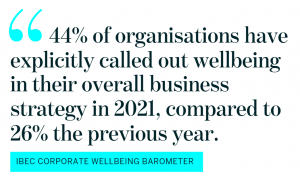
Even before COVID-19, wellbeing was becoming a greater priority for many organisations knowing that it has a profound effect on both individual and organisational performance. While the pandemic may have catalysed the focus on workplace wellbeing, it is leaders who are paving the way to ensure that it becomes an integral pillar within their organisational culture. Embedding practices and initiatives into the overall business strategy and ensuring they are played out daily, will have the greatest impact on employee wellbeing.
The session was led by HPC’s Fiona Claridge and Fergal O’Connor, who invited valued opinions from guest contributor, Sarah Healy, Global Director for L&D at Mastercard. Adding strength to her L&D role, Sarah is an MSc level Psychological Coach and a Team Culture and Dynamics specialist. Fergal is a senior facilitator within HPC’s leadership development team, working with organisations to instil behavioural change. He is also an ultra-marathon runner and therefore is no stranger to the idea of promoting wellness.
Within the session, L&D leaders were eager to facilitate debate around topics such as leveraging social connections to support overall wellbeing; habits that employers can demonstrate to employees to lead by example; and fostering better team dynamics.
Fine tuning the focus
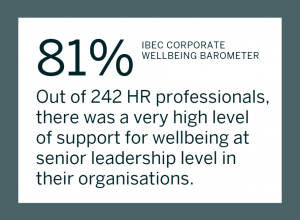 Until recently, gym membership or a yoga class at lunchtime was as far as employee wellbeing programmes went for many companies. But as many leaders are now realising, it’s about much more than that and wellbeing is supported at senior level across many organisations. In order to retain employees, and to ensure they are happy in their jobs, you need to make them feel safe, included, needed. So how can leaders tap into and achieve that?
Until recently, gym membership or a yoga class at lunchtime was as far as employee wellbeing programmes went for many companies. But as many leaders are now realising, it’s about much more than that and wellbeing is supported at senior level across many organisations. In order to retain employees, and to ensure they are happy in their jobs, you need to make them feel safe, included, needed. So how can leaders tap into and achieve that?
“We end up spending 90,000 hours of our life in work and the experience we have with our teams makes up the majority of our work experience,” Sarah pointed out. Therefore, leaders must ensure that the team dynamic is strong enough to support the individuals within that team.
“Does the team have clarity of purpose? Are leaders giving autonomy or micromanaging? Is psychological safety considered? This means how safe the team feels – are they safe to contribute, to admit mistakes or challenge something?” Sarah said. In allowing this, it will increase productivity, creativity and create less stress, which in a way will have a more positive impact than that one-hour yoga class.

Striking the right habits
One of the most effective ways a leader can address wellbeing is through their personal habits. If an employer is seen to be working at 6am or 10pm, employees may feel they should follow suit – particularly young employees who are trying to create a good impression.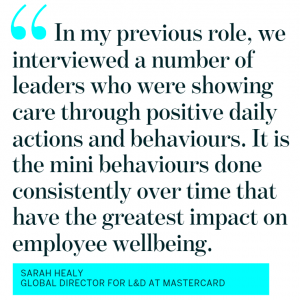
A good habit some leaders have is around using ‘click send later’ if they have written an email to employees after 5pm. Getting an email from the boss, no matter how good a relationship you have with them, often creates a stress response. Sarah says that hitting ‘click send later’ creates a culture of care and wellbeing and lets the employee know they don’t have to respond till the next morning.
Sarah suggests, “Talk to your team about what works for them – standing/walking/video free meetings, taking regular breaks or quirky new things. You need to role model self-care, and if you’re not switching off in the evening, people follow your actions not your words.”
No meeting days were also discussed but leaders should be careful when considering what constitutes stress reduction. Sometimes no meeting days can cause more stress if the team needs to work together on a deliverable.
It’s about building the skills within leaders to help them create a good dynamic for the group of people that report directly to them and then customising this to what works best for their team. Highlight the importance of the leader’s role in both their own wellbeing and that of their team. Creating a leadership circle to explore ideas, gain buy-in and ensure accountability can ensure that wellbeing initiatives and behaviours gain momentum.
The importance of culture
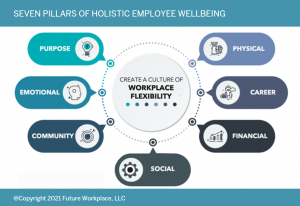 Employee wellbeing has expanded beyond physical wellbeing that includes exercise, sleep, overall lifestyle, and nutrition. The focus is now on building a holistic culture of wellbeing at the heart of the organisation, which is critical to relationship building, developing workplace resilience and high performing teams.
Employee wellbeing has expanded beyond physical wellbeing that includes exercise, sleep, overall lifestyle, and nutrition. The focus is now on building a holistic culture of wellbeing at the heart of the organisation, which is critical to relationship building, developing workplace resilience and high performing teams.
Future Workplace has identified seven pillars of employee wellbeing to guide leaders as they prioritise their wellbeing strategies. These seven pillars include physical, emotional, financial, social, career, community, and purpose. At the heart of this is the growing need for flexibility in where, when, and how employees work.
Within this wider organisational culture, leaders should ensure that team dynamics are aligned and that the team is operating in an environment where there’s clarity, autonomy and safety.
The Role of the Leader
“All the initiatives in the world won’t make a difference if an individual’s manager doesn’t show care about employee wellbeing. Saying they care is common, but this is very different from showing care through daily actions and behaviours,” Sarah stressed.
The employee/manager relationship is a critical driver of an impactful employee experience, which unlocks potential, performance, and impact. It is the bedrock for instilling belonging, wellbeing, inclusion, trust, culture, and contribution. Gallup research states that managers are responsible for at least 70% of the variance in their employees’ engagement. Sometimes leaders don’t realise they’re having that big an impact on employees.
Find out regularly what your team’s needs are. Schedule regular one-on-one meetings to check in on work commitments, but also to reach out to check in on how they are doing personally. This makes employees feel like they’re being cared for and valued.
Sarah discussed a fascinating sleep study carried out by WHOOP that looked at the impact a leader’s lack of sleep had on their team meeting the next day. The research was done with teams that were high performing – employees felt safe with that leader – but when the leader was sleep deprived, the psychological safety scores dropped. Just think about negative impact that lack of sleep is having on the wellbeing of teams where the leader doesn’t know about psychological safety in the first place.
IBEC’s research states that 74% of HR professionals expect an increased focus on management skills in managing employee mental wellbeing over the next 2 to 3 years. Sarah echoed this when she said that “when leaders know how to create and foster high performing team cultures based on individual needs and culture, that’s when you’ll have the biggest impact on wellbeing.”
The importance of social connections
The group recognised that social connections are hugely important, and team building events off site are vital. Also discussed was new research around how you can bring a group of people together to solve wellbeing challenges as a collective through ‘relational pauses.’ Before jumping into a group project, spend 5-10 minutes every 3-4 weeks briefly checking in with your team – how you are finding the work you’re doing? Are meetings productive? Are there enough break times? Are we actively listening to each other? What impact are we having? What should we do more of? The group then takes on a collective role of addressing individual problems in a caring and collaborative way.
“In one of my favourite studies, researchers measured individual perception of climbing a mountain when alone or with one other person. When alone, the mountain felt higher and more challenging. In terms of wellbeing at work, we need to make it collective focus vs an individual one. it’s about framing it as ‘we’re all in it together’ and “lets come up with the solutions together,” Sarah says.
It’s also about asking people what they want, what will be meaningful for them. There is no one size fits all when trying to diagnose what wellbeing is; it is different for different demographics and ages. It’s also important to build on opportunities for people to meet and collaborate cross departmentally as well as in their own team.
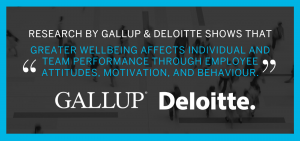
Hybrid is here to stay, the discussion group felt, therefore when asking people to come to an office, it’s about making it meaningful, offering a sense of belonging, and there is a responsibility on leadership to create that sense of meaning. If staying remote, leaders must be cognisant of onboarding new employees and how to do that successfully in a remote setting.
Getting creative
Fergal asked the question “how can traditional institutes apply principles of creativity?” One L&D Director said that from an innovation standpoint it’s good to break the long-standing thought processes – to view problems in a different way, even in very rigid settings. By doing so in a social group, it invites diversity of thought and sharing ideas and resources.
Another company uses Mount Everest as a metaphor for building the company and working towards ‘Camp 2’, having taken five years to complete ‘Camp 1’. The metaphor of the climb has underpinned everything they have done. Some people aren’t into climbing but they were given the opportunity to align or not. “Clear leadership creates higher purpose, and it means you are on the trek together, which also ties into the social piece,” Sarah acknowledged.
Takeaways
The roundtable discussion ended with several key takeaways including the importance of team engagement, particularly when remote working and to improve the overall dynamics within that team through good leadership. Positive habits, understanding employee needs, role modelling, internal initiatives and personal gestures – all done consistently over time foster positive wellbeing and contribute to superior team performance.
As one participant pointed out, “we are wired for meaning, and as leaders we should be tying the workday into our larger meaning and purpose.”


This discussion was part of our HPC Talks series – a small quarterly forum to discuss topics and issues relevant to the world of L&D. If you would like to be kept informed of future events, please contact fiona.claridge@wearehpc.com
HPC Talks Contributors
Sarah Healy – Mastercard

Sarah is a global leader in Learning & Organisational Capability, specialising in Leadership Development & Talent Management. Prior to her recent appointment as Global Director of L&D at Mastercard, she worked in Facebook, Optus, Australia and Deloitte.
She is an MSc level Psychological Coach and a Team Culture and Dynamics specialist. Leveraging neuroscience for team performance and impact, she supports individuals and teams to build and prioritise workplace wellbeing. She is also a Positive Psychology Practitioner (MAPP) and has implemented highly effective resilience, psychological safety, and strengths-based interventions within corporate teams. She is currently completing a second MSc in Performance Psychology with a research focus on “Building Psychological Resilience & Mental Toughness to Enhance Performance”.
Connect with Sarah on LinkedIn >>>
Fergal O’Connor – HPC
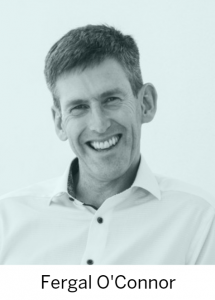
Fergal is an experienced facilitator and executive coach and has been a member of HPC’s leadership and management development team since 2006.Fergal’s work with HPC focuses on the development of a high-performance culture for our clients with a particular emphasis on accountability and feedback. He has an energetic, engaging style that combines appropriate levels of challenge and support.
Fergal has over 17 years’ experience working in middle and senior management positions in American multinational corporations and Irish indigenous companies such as: Dell Computers, Seagate Technologies, Western Digital Corp. and Fitzgerald Packaging Ltd. During this time, he had responsibility for developing his people through effective and regular performance reviews and coaching.
In 2004, Fergal moved into training and coaching and uses his commercial skills and experience to complement the programmes he delivers. He delivers management training programmes, facilitates team effectiveness sessions and provides a range of specialist people development solutions to a wide range of HPC clients across Ireland and beyond.
Connect with Fergal on LinkedIn >>>
Connect with HPC on LinkedIn >>>
Fiona Claridge – HPC

Fiona’s role as Client Director within HPC is to partner with organisations to shape bespoke people development solutions that achieve impactful results. She works in partnership with clients across a diverse range of industry sectors and offers a deep understanding of how ever-changing business needs impact how HPC’s work adds value at a strategic level.
HPC has been designing and delivering people development solutions for 40 years, partnering with clients to create a high-performance culture that has a positive impact on business growth and personal development.
Connect with Fiona on LinkedIn >>>